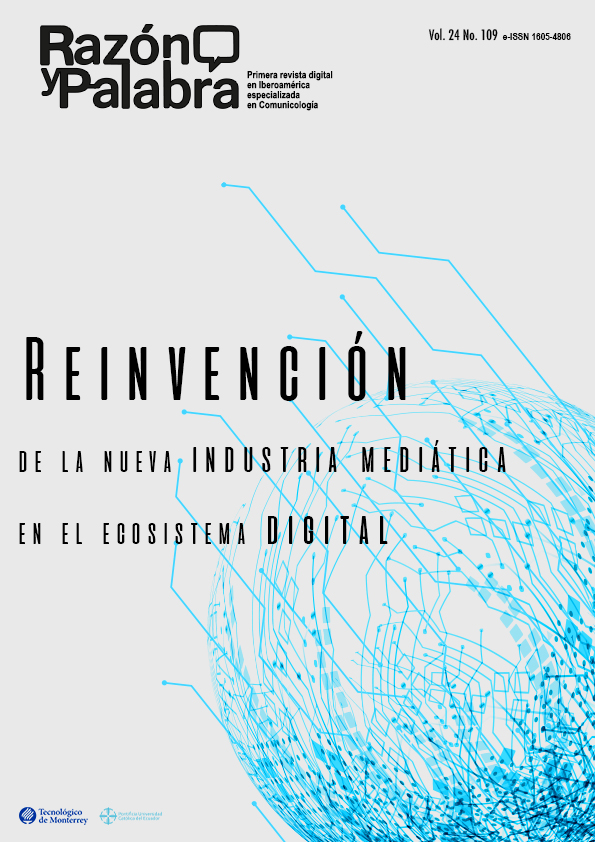The effects of COVID19 on Ecuadorian analogue television and WebTV an opportunity to establish relationship marketing models with the audience
Main Article Content
Abstract
The COVID19 health crisis is playing a leading part in television worldwide. TV is taking a leading role in its role of offering information and entertainment to citizens. This research reflects on the capacity of Ecuadorian television to capitalize on the short and medium term the recovery of non-existing audiences, especially youth audiences, who are now turning to linear and digital platforms. Interviews with representatives of the main national television stations and academic experts in communication have been carried out to reflect on the internal and external aspects that affect innovation in the Ecuadorian television sector and COVID19 effects on the digital platform. In addition, a descriptive analysis of the main consumption metrics of the WebTV of the largest channels was carried out. Also, two discussion groups took place with students in the field of Communication in order to understand their perspective on national TV in the current crisis. The information, flag of the Ecuadorian TV currently provides a great audience to linear and digital television. The article casts light on the existence of a television with structural problems that prevent it from adopting innovative strategies. Young audiences do not adopt national television as ours. The credibility factor and the apathy produced by the grill offer are some of the main aspects that prevent these audiences from connecting with the medium, both in its linear and digital platforms.
Downloads
Article Details

This work is licensed under a Creative Commons Attribution 4.0 International License.
References
Agencia de regulación y Control de las Telecomunicaciones (ARCOTEL). (2020). Servicio de suscripción- Televisión pagada. Suscriptores. Quito: Arcotel.
Barlovento Comunicación (2020). Cambio de hábitos y preferencias de la ciudadanía española frente al televisor por la crisis del coronavirus. Informe
especial, marzo 2020. Recuperado de shorturl.at/pxBEY
Bravo-Mancero, J., Larrea Naranjo, C., & Ruales Parreño, R. (2020). Tratamiento del Covid 19, Ecuador mediante el humor periodístico. Brazilian Journal of Health Review, 3(2), 3523-3541.
Casero-Ripollés, A. (2020a). Impact of Covid-19 on the media system. Communicative and democratic consequences of news consumption during the outbreak. El profesional de la información, 29(2), e290223. https://doi.org/10.3145/epi.2020.mar.23
Casero-Ripollés, A. (2020b). Influence of media on the political conversation on Twitter: Activity, popularity, and authority in the digital debate in Spain. Icono14. Revista científica de comunicación y tecnologías emergentes, 18(1), 33-57. https://doi.org/10.7195/ri14.v18i1.1527
Cruz, P.J., Valarezo-Quevedo, A., & Castañeda, P. (2017). Transmediación y transformatización en la ficción televisiva de Ecuador: análisis de recepción de narrativas de humor. Tsafiqui - Revista Científica En Ciencias Sociales, 7(8), 24-35. https://doi.org/10.29019/tsafiqui.v0i8.163
Expansión (2020). Ecuador-Emigrantes totales. https://datosmacro.expansion.com/demografia/migracion/emigracion/ecuador
García Carrizo, J., & Heredero Díaz, O. (2015). Propuesta de un modelo genérico de análisis de la estructura de las narrativas transmedia. Icono 14(13), 260-285. https://doi.org/10.7195/ri14.v13i2.745
Hallo, A., Rojas, A., & Hallo, C. (2020). Perspective from Ecuador, the Second Country with More Confirmed Cases of Coronavirus Disease 2019 in South America: A Review. Cureus, 12(3), e7452. https://doi.org/10.7759/cureus.7452
INEC. (2020). Tecnologías de la Información y Comunicación. Encuesta multipropósito-TIC 2019. Quito: INEC. Recuperado de https://www.ecuadorencifras.gob.ec/tecnologias-de-la-informacion-y- comunicacion-tic/
INEC. (2019). Tecnologías de la Información y Comunicación. Encuesta multipropósito-TIC 2018. Quito: Recuperado de https://www.ecuadorencifras.gob.ec/tecnologias-de-la-informacion-y-comunicacion-tic/
Instituto Geográfico Militar. (2018). Situación, perspectivas, desafíos y oportunidades para la transformación digital y la reducción de la brecha digital en el ámbito geoespacial. Ecuador: Instituto Geográfico Militar.
Kirby, T. (2020). South America prepares for the impact of COVID-19. The Lancet Respiratory Medicine, 8(6), 551-552. https://doi.org/10.1016/S2213-
(20)30218-6
La Publicidad (2020, 09 de junio). Perú y Ecuador lideran el aumento del rating de TV abierta. La Publicidad. Recuperado de https://lapublicidad.net/peru-y-ecuador-lideran-el-aumento-de-rating-de-tv-abierta/
Lázaro-Rodríguez, P., & Herrera-Viedma, E. (2020). Noticias sobre Covid-19 y 2019-nCoV en medios de comunicación de España: el papel de los medios digitales en tiempos de confinamiento. El profesional de la información, 29(3), e290302.
Martínez, O. (2020, 07 de marzo). Aumenta la crisis en la televisión ecuatoriana. Diario Última Hora. Recuperado de https://ultimahoraec.com/aumenta-la-crisis- en-la-television-ecuatoriana/
Masip, P., Aran-Ramspott, S., Ruiz-Caballero, C., Suau, J., Almenar, E., & Puertas- Graell, D. (2020). Consumo informativo y cobertura mediática durante el confinamiento por el Covid-19: sobreinformación, sesgo ideológico y sensacionalismo. El profesional de la información, 29(3) e290312. https://doi.org/10.3145/epi.2020.may.12
Mendizábal, I. (2012). Calidad informativa: credibilidad de medios y periodistas en el Ecuador. ComHumanitas, 3(3), 53-69.
Navarro, J. C., Arrivillaga-Henríquez, J., Salazar-Loor, J., & Rodríguez-Morales, A. J. (2020). COVID-19 and dengue, co-epidemics in Ecuador and other countries in Latin America: Pushing strained health care systems over the edge. Travel medicine and infectious disease. Advance online publication, 1-2. https://doi.org/10.1016/j.tmaid.2020.101656
Newman, N., Fletcher, R., Kalogeropoulos, A., & Nielsen, R.K. (2020). Reuters Institute digital news report 2019. Oxford: Reuters Institute for the Study of Journalism.
Ortiz-León, C., & Suing, A. (2016). La televisión ecuatoriana: pasado y presente. Razón y palabra, 93(20), 135-152.
Pérez-Dasilva, J-A., Meso-Ayerdi, K., & Mendiguren-Galdospín, T. (2020). Fake news y coronavirus: detección de los principales actores y tendencias a través del análisis de las conversaciones en Twitter. El profesional de la información (3), e290308. https://doi.org/10.3145/epi.2020.may.08
Punto Noticias (2020, 23 de enero). Sintonía en medios de comunicación cayó en un 50% debido a su baja credibilidad. Punto Noticias. Recuperado de http://www.pichinchacomunicaciones.com.ec/sintonia-en-medios-de- comunicacion-cayo-en-un-50-debido-a-su-baja-credibilidad/
Quiroga Macleimont, S.R. (2016). Nuevas narrativas y transmedia: la actividad de las audiencias. Questión. Revista Especializada en Periodismo y Comunicación, 1(51), 284-301.
Salaverría, R., Buslón, N., López-Pan, F., León, B., López-Goñi, I., & Erviti, M-C. (2020). Desinformación en tiempos de pandemia: tipología de los bulos sobre la Covid-19. El profesional de la información, 29(3), e290315. https://doi.org/10.3145/epi.2020.may.15
Scolari, C. (2008). Hipermediaciones. Elementos para una Teoría de la Comunicación Digital Interactiva. Barcelona: Editorial Gedisa.
Scolari, C. (2014). Narrativas transmedia: nuevas formas de comunicar en la era digital. Madird: AC/E de Cultura Digital.







